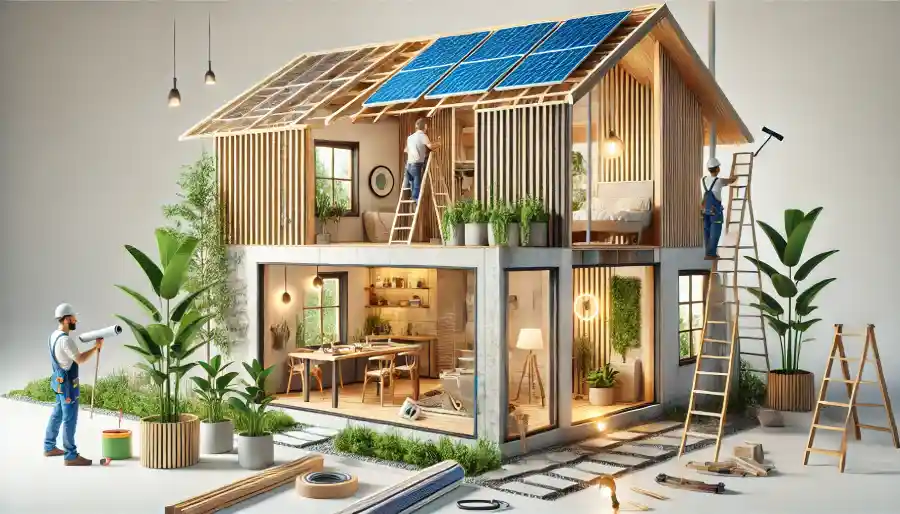Eco-Friendly Home Remodeling: Tips and Tricks for a Sustainable Renovation
Introduction to Eco-Friendly Remodeling
Remodeling your home offers an excellent chance to embrace sustainability. With increasing awareness about the environmental impact of our choices, more homeowners are integrating eco-friendly elements into their renovation plans. Companies like Striking Remodels are leading the way, showcasing the potential of sustainable remodeling in everyday homes. Embracing eco-friendly remodeling not only contributes to the health of our planet but also yields significant benefits for homeowners, from long-term cost savings to healthier living environments.
Eco-friendly remodeling focuses on reducing carbon footprints and involves using sustainable materials, energy-efficient appliances, and practices that conserve water. The benefits extend beyond environmental impact—creating a healthier, more cost-effective living space is one of the significant advantages of integrating eco-friendly practices in your home remodel.
Why Choose Sustainable Materials?
Using sustainable materials is fundamental to eco-friendly remodeling. These materials are responsibly sourced and manufactured to limit environmental impact. For instance, bamboo flooring is popular due to its rapid growth cycle and ability to regenerate without replanting. Similarly, recycled glass countertops are made from post-consumer glass, reducing waste and the need for virgin materials. According to the EPA, sustainable materials management is crucial for reducing greenhouse gas emissions, conserving resources, and minimizing waste.
Sustainable materials also offer aesthetic and practical benefits. Reclaimed wood, for example, can add character to your home with its unique texture and history. Additionally, many eco-friendly materials are durable and require less maintenance, providing a cost-effective solution in the long run. By choosing sustainably sourced materials, you contribute to preserving ecosystems and creating a healthier living environment inside your home.
Energy-Efficient Appliances
Switching to energy-efficient appliances can profoundly affect your home’s energy consumption. Refrigerators, washing machines, and dishwashers with the ENERGY STAR label use significantly less power and water than traditional models. Not only does this reduce your environmental footprint, but it also lowers utility bills, making energy-efficient appliances a smart investment for any eco-conscious homeowner.
Moreover, energy-efficient appliances often feature advanced technologies that enhance functionality and convenience. For example, smart thermostats learn your schedule and adjust the temperature automatically, maximizing energy savings without compromising comfort. The combined effect of these devices can substantially reduce your home’s carbon footprint, contributing to broader environmental goals while improving your quality of life.
Water-Saving Fixtures
Water conservation is another essential component of eco-friendly remodeling. Installing water-saving fixtures such as low-flow toilets, faucets, and showerheads can dramatically cut water usage. Modern fixtures are designed to maintain performance while using less water, making them a win-win for the environment and your wallet. Water-efficient appliances such as washing machines and dishwashers can reduce water consumption, contributing to overall sustainability.
Effective water management is vital, given the growing concerns around water scarcity. By incorporating water-saving fixtures, you not only reduce your water bills but also help alleviate pressure on local water supplies. Additionally, some municipalities offer rebates and incentives for installing water-efficient products, adding another layer of financial benefit.
Enhancing Indoor Air Quality
A setting that is conducive to health requires good indoor air quality. Select low-VOC (volatile organic compound) paints and finishes during remodeling to reduce the amount of dangerous chemicals released into the air. Air quality can be enhanced by appropriate ventilation systems, which lower indoor pollutants and moisture content. Additionally, using non-toxic building materials helps to create a cleaner and healthier indoor atmosphere, reducing potential health risks for you and your family.
To ensure optimum indoor air quality, proper insulation is also essential. It helps control inside temperature and keeps outside contaminants out of your living area, saving you money on artificial heating and cooling. In addition to saving energy, this can improve indoor comfort and health.
Recycling and Reusing
Incorporating recycling and reusing practices into your remodel can significantly reduce the environmental impact of your project. Instead of discarding old materials, consider donating them to architectural salvage yards or non-profits. These materials can then be repurposed for future projects, reducing waste. Reusing materials helps the environment and adds unique character to your home, making it one-of-a-kind.
Additionally, consider integrating recycled materials into your remodel. Recycled metal, glass, and plastic can be used in various applications, from countertops to light fixtures. By choosing recycled products, you support markets for recyclable materials, encourage further recycling efforts, and contribute to a more sustainable economy.
Outdoor Sustainability
Sustainable practices should extend to your outdoor spaces as well. Planting native species in your garden can reduce the need for water and maintenance, as these plants are adapted to local conditions and more resilient to pests. Installing rainwater harvesting systems can provide an eco-friendly alternative to tap water for irrigation, reducing your reliance on municipal water supplies and lowering your water bills.
Using permeable paving materials helps manage stormwater runoff, reduces soil erosion, and contributes to better water management in your yard. These materials allow water to infiltrate the ground, replenishing groundwater supplies and reducing the risk of flooding. Creating a sustainable outdoor space enhances the overall eco-friendliness of your home, providing a harmonious and environmentally responsible living environment.
Conclusion
Eco-friendly home remodeling is a powerful way to support sustainability while enhancing your home’s comfort and value. By opting for sustainable materials, energy-efficient appliances, water-saving fixtures, and practices that improve indoor air quality and promote recycling, you can create a space that’s not only beautiful but also environmentally responsible. Remember, every step towards sustainability counts, and your efforts can inspire others to follow suit, contributing to a more sustainable future for all.

